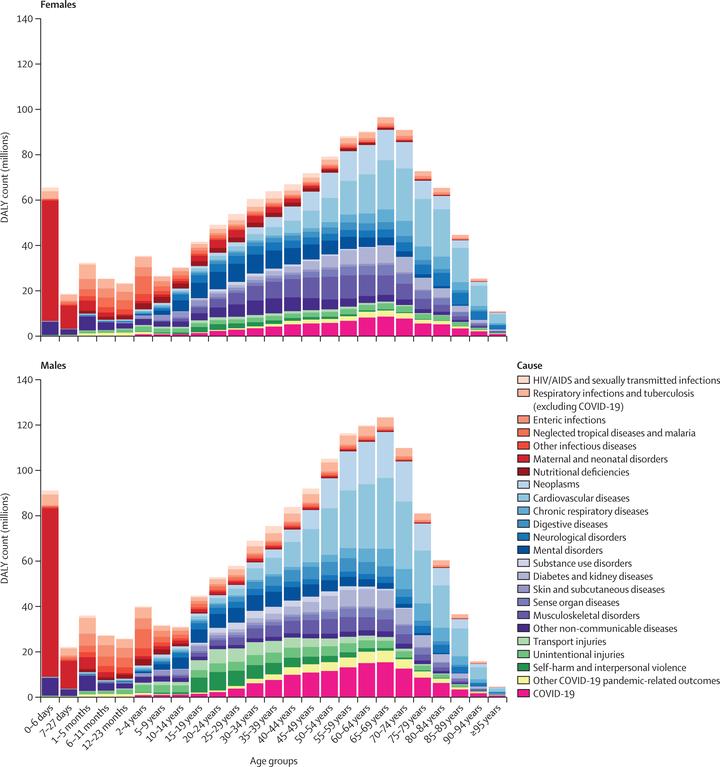Global incidence, prevalence, years lived with disability (YLDs), disability-adjusted life-years (DALYs), and healthy life expectancy (HALE) for 371 diseases and injuries in 204 countries and territories and 811 subnational locations, 1990–2021: a systematic analysis for the Global Burden of Disease Study 2021

Abstract
Detailed, comprehensive, and timely reporting on population health by underlying causes of disability and premature death is crucial to understanding and responding to complex patterns of disease and injury burden over time and across age groups, sexes, and locations. The availability of disease burden estimates can promote evidence-based interventions that enable public health researchers, policy makers, and other professionals to implement strategies that can mitigate diseases. It can also facilitate more rigorous monitoring of progress towards national and international health targets, such as the Sustainable Development Goals. For three decades, the Global Burden of Diseases, Injuries, and Risk Factors Study (GBD) has filled that need. A global network of collaborators contributed to the production of GBD 2021 by providing, reviewing, and analysing all available data. GBD estimates are updated routinely with additional data and refined analytical methods. GBD 2021 presents, for the first time, estimates of health loss due to the COVID-19 pandemic.
The GBD 2021 disease and injury burden analysis estimated years lived with disability (YLDs), years of life lost (YLLs), disability-adjusted life-years (DALYs), and healthy life expectancy (HALE) for 371 diseases and injuries using 100 983 data sources. Data were extracted from vital registration systems, verbal autopsies, censuses, household surveys, disease-specific registries, health service contact data, and other sources. YLDs were calculated by multiplying cause-age-sex-location-year-specific prevalence of sequelae by their respective disability weights, for each disease and injury. YLLs were calculated by multiplying cause-age-sex-location-year-specific deaths by the standard life expectancy at the age that death occurred. DALYs were calculated by summing YLDs and YLLs. HALE estimates were produced using YLDs per capita and age-specific mortality rates by location, age, sex, year, and cause. 95% uncertainty intervals (UIs) were generated for all final estimates as the 2·5th and 97·5th percentiles values of 500 draws. Uncertainty was propagated at each step of the estimation process. Counts and age-standardised rates were calculated globally, for seven super-regions, 21 regions, 204 countries and territories (including 21 countries with subnational locations), and 811 subnational locations, from 1990 to 2021. Here we report data for 2010 to 2021 to highlight trends in disease burden over the past decade and through the first 2 years of the COVID-19 pandemic.
Global DALYs increased from 2·63 billion (95% UI 2·44–2·85) in 2010 to 2·88 billion (2·64–3·15) in 2021 for all causes combined. Much of this increase in the number of DALYs was due to population growth and ageing, as indicated by a decrease in global age-standardised all-cause DALY rates of 14·2% (95% UI 10·7–17·3) between 2010 and 2019. Notably, however, this decrease in rates reversed during the first 2 years of the COVID-19 pandemic, with increases in global age-standardised all-cause DALY rates since 2019 of 4·1% (1·8–6·3) in 2020 and 7·2% (4·7–10·0) in 2021. In 2021, COVID-19 was the leading cause of DALYs globally (212·0 million [198·0–234·5] DALYs), followed by ischaemic heart disease (188·3 million [176·7–198·3]), neonatal disorders (186·3 million [162·3–214·9]), and stroke (160·4 million [148·0–171·7]). However, notable health gains were seen among other leading communicable, maternal, neonatal, and nutritional (CMNN) diseases. Globally between 2010 and 2021, the age-standardised DALY rates for HIV/AIDS decreased by 47·8% (43·3–51·7) and for diarrhoeal diseases decreased by 47·0% (39·9–52·9). Non-communicable diseases contributed 1·73 billion (95% UI 1·54–1·94) DALYs in 2021, with a decrease in age-standardised DALY rates since 2010 of 6·4% (95% UI 3·5–9·5). Between 2010 and 2021, among the 25 leading Level 3 causes, age-standardised DALY rates increased most substantially for anxiety disorders (16·7% [14·0–19·8]), depressive disorders (16·4% [11·9–21·3]), and diabetes (14·0% [10·0–17·4]). Age-standardised DALY rates due to injuries decreased globally by 24·0% (20·7–27·2) between 2010 and 2021, although improvements were not uniform across locations, ages, and sexes. Globally, HALE at birth improved slightly, from 61·3 years (58·6–63·6) in 2010 to 62·2 years (59·4–64·7) in 2021. However, despite this overall increase, HALE decreased by 2·2% (1·6–2·9) between 2019 and 2021.